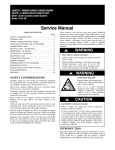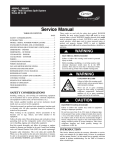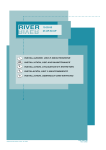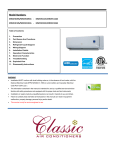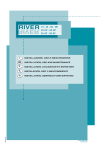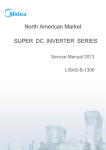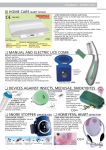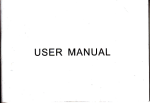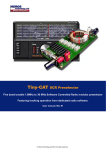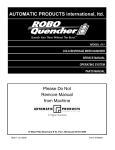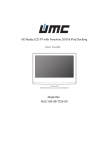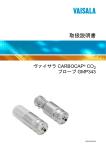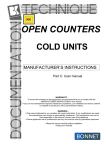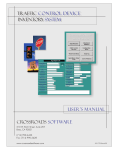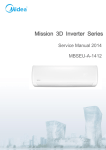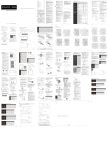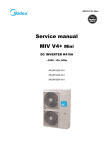Download Service Manual - DCNE Ductless and VRF
Transcript
40MBC/40MBD/40MBF/38MAQ/38MBQ 619RC/619RD/619RF/538PR/538RR Cassette, Ducted, Floor Console Single Zone Ductless Split System Sizes 09 to 48 Service Manual TABLE OF CONTENTS PAGE SAFETY CONSIDERATIONS . . . . . . . . . . . . . . . . . . . . . . . . . 1 INTRODUCTION . . . . . . . . . . . . . . . . . . . . . . . . . . . . . . . . . . . 1 SERIAL NUMBER NOMENCLATURE . . . . . . . . . . . . . . . . . . 2 STANDARD FEATURES AND ACCESSORIES . . . . . . . . . . . 3 SPECIFICATIONS . . . . . . . . . . . . . . . . . . . . . . . . . . . . . . . . 4--6 DIMENSIONS/CLEARANCES . . . . . . . . . . . . . . . . . . . . . 7--16 ELECTRICAL DATA . . . . . . . . . . . . . . . . . . . . . . . . . . . . . . . 14 WIRING . . . . . . . . . . . . . . . . . . . . . . . . . . . . . . . . . . . . . . . . . . 14 CONNECTION DIAGRAMS . . . . . . . . . . . . . . . . . . . . . . . . . 15 WIRING DIAGRAMS . . . . . . . . . . . . . . . . . . . . . . . . . . . . 19--24 SOUND PRESSURE . . . . . . . . . . . . . . . . . . . . . . . . . . . . . . . . 25 REFIGERATION CYCLE DIAGRAMS . . . . . . . . . . . . . . . . . 26 SYSTEM EVACUATION AND CHARGING . . . . . . . . . . . . . 27 TROUBLESHOOTING . . . . . . . . . . . . . . . . . . . . . . . . . . . . . . 31 APPENDIX . . . . . . . . . . . . . . . . . . . . . . . . . . . . . . . . . . . . . . . 51 These words are used with the safety--alert symbol. DANGER identifies the most serious hazards which will result in severe personal injury or death. WARNING signifies hazards which could result in personal injury or death. CAUTION is used to identify unsafe practices which may result in minor personal injury or product and property damage. NOTE is used to highlight suggestions which will result in enhanced installation, reliability, or operation. WARNING ! ELECTRICAL SHOCK HAZARD Failure to follow this warning could result in personal injury or death. Before installing, modifying, or servicing system, the main electrical disconnect switch must be in the OFF position. There may be more than 1 disconnect switch. Lock out and tag switch with a suitable warning label. ! SAFETY CONSIDERATIONS Installing, starting up, and servicing air--conditioning equipment can be hazardous due to system pressures, electrical components, and equipment location (roofs, elevated structures, etc.). Only trained, qualified installers and service mechanics should install, start--up, and service this equipment. Untrained personnel can perform basic maintenance functions such as cleaning coils. All other operations should be performed by trained service personnel. When working on the equipment, observe precautions in the literature and on tags, stickers, and labels attached to the equipment. Follow all safety codes. Wear safety glasses and work gloves. Keep quenching cloth and fire extinguisher nearby when brazing. Use care in handling, rigging, and setting bulky equipment. Read this manual thoroughly and follow all warnings or cautions included in literature and attached to the unit. Consult local building codes and National Electrical Code (NEC) for special requirements. Recognize safety information. This is the safety--alert symbol !! . When you see this symbol on the unit and in instructions or manuals, be alert to the potential for personal injury. Understand these signal words: DANGER, WARNING, and CAUTION. WARNING EXPLOSION HAZARD Failure to follow this warning could result in death, serious personal injury, and/or property damage. Never use air or gases containing oxygen for leak testing or operating refrigerant compressors. Pressurized mixtures of air or gases containing oxygen can lead to an explosion. ! CAUTION EQUIPMENT DAMAGE HAZARD Failure to follow this caution may result in equipment damage or improper operation. Do not bury more than 36 in. (914 mm) of refrigerant pipe in the ground. If any section of pipe is buried, there must be a 6 in. (152 mm) vertical rise to the valve connections on the outdoor units. If more than the recommended length is buried, refrigerant may migrate to the cooler buried section during extended periods of system shutdown. This causes refrigerant slugging and could possibly damage the compressor at start--up. INTRODUCTION This Service Manual provides the necessary information to service, repair, and maintain the family of heat pumps. Section 2 of this manual has an appendix with data required to perform troubleshooting. Use the Table of Contents to locate a desired topic. SERIAL NUMBER NOMENCLATURES 01 15 V Week of Manufacture 10001 Sequential Serial Number V = ALL MODELS Year of Manufacture Use of the AHRI Certified TM Mark indicates a manufacturer’s participation in the program For verification of certification for individual products, go to www.ahridirectory.org. 2 STANDARD FEATURES AND ACCESSORIES Ease Of Installation Mounting Brackets Low Voltage Controls Comfort Features Microprocessor Controls Wired Remote Control Wireless Remote Control Automatic Horizontal Air Sweep Air Direction Control Auto Restart Function Cold Blow Protection On Heat Pumps Freeze Protection Mode On Heat Pumps Turbo Mode Silence Mode Auto Changeover On Heat Pumps Follow Me Energy Saving Features Sleep Mode Stop/Start Timer 46° F Heating Mode (Heating Setback) Safety And Reliability 3 Minute Time Delay For Compressor Over Current Protection For Compressor Indoor Coil Freeze Protection Indoor Coil High Temp Protection in Heating Mode Condenser High Temp Protection in Cooling Mode Ease Of Service And Maintenance Cleanable Filters Diagnostics Liquid Line Pressure Taps Application Flexibility Condensate Pumps Crankcase Heater Base pan Heater Legend S Standard A Accessory S S S A S S S S S S S S S INDOOR UNITS ACCESSORIES Grille: To maximize shipping efficiency, the grille for the in--ceiling cassette is set up as an accessory. NOTE: Grille is required. OUTDOOR UNITS Crankcase Heater Standard on all unit sizes. Heater clamps around compressor oil stump. S S S S S S S S S S S S A S S 3 SPECIFICATIONS -- CASSETTE HEAT PUMP Table 1—Cassette Specifications Size System Performance 9 12 18 Outdoor Model 38MAQB09------3 538PEQ009RBMA 38MAQB12------3 538PEQ012RBMA 38MAQB18------3 538PEQ018RBMA Indoor Model 40MBQB09C----3 619REQ009CBMA 40MBQB12C----3 619REQ012CBMA 40MBQB18C----3 619REQ018CBMA Cooling Rated Capacity Btu/h 9,000 12,000 16,000 Cooling Cap. Range Min -- Max Btu/h 3,500~11,000 4,000~13000 4,500~18,000 SEER 19.0 20.5 19.0 EER 13.0 13.0 12.5 Heating Rated Capacity Btu/h 10,000 12,000 18,000 Heating Cap. Range Min -- Max Btu/h 4,500~11,500 5,000~13500 5,500~19,000 10.0 10.0 9.0 HSPF Controls Operating Range Piping Wireless Remote Controller (F/C Convertible) Standard Wired Remote Controller (F/C Convertible) Cooling Outdoor DB Min -- Max Optional --4~122 --4~122 --4~122 Heating Outdoor DB Min -- Max _F _F --4~86 --4~86 --4~86 Total Piping Length Ft. 82 82 98 Piping Lift* Ft. 32 32 65 Pipe Connection Size -- Liquid In. 1/4 1/4 1/4 Pipe Connection Size -- Suction In. 3/8 1/2 1/2 Type Refrigerant Design Pressure PSIG 2.76 2.76 4.19 9.2 9.2 16.0 No. Rows 2 2 2 Fins per inch 21 21 18 Face Area Sq. Ft. 4 4 6 3.1 3.1 3.1 No. Rows 1 2 2 Fins per inch 19 19 19 Circuits 2 4 4 Type Hermetic Rotary DC Inverter Compressor Model ASM98D1UFZA ASM108D1UFZA ASM135D23UFZ VG74 VG74 VG74 Fl. Oz. 12.5 12.5 15.2 RLA 5.3 5.7 7.3 V/Ph/Hz 208/230--1--60 208/230--1--60 208/230--1--60 MCA A. 15 15 MOCP -- Fuse Rating A. 15 15 20 Unit Width In. 31.9 31.9 33.3 Unit Height In. 22.0 22.0 27.6 Unit Depth In. 12.2 12.2 12.6 Net Weight Lbs. 82.5 82.5 102.5 Airflow CFM 945 945 1050 Sound Pressure dB(A) 56 56 59 Body Unit Width In. 22.4 22.4 22.4 Body Unit Height In. 10.2 10.2 10.2 Body Unit Depth In. 22.4 22.4 22.4 Body Net Weight Lbs. 35.3 35.3 39.7 Panel Unit Width In. 25.5 25.5 25.5 Panel Unit Height In. 2.0 2.0 2.0 Panel Unit Depth In. 25.5 25.5 25.5 Panel Net Weight Lbs. 5.5 5.5 5.5 3 3 3 Oil Type Oil Charge Rated Current Voltage, Phase, Cycle Electrical Outdoor Indoor 550 Lbs. Circuits Compressor 550 Capillary Tube in Outdoor Unit Sq. Ft. Face Area Indoor Coil 550 Metering Device Charge Outdoor coil R410A Power Supply Indoor unit powered from outdoor unit Number of Fan Speeds 15 Airflow (lowest to highest) CFM 260/320/380 280/340/400 290/350/420 Sound Pressure (lowest to highest) dB(A) 34/39/44 36/39/42 46/48/50 * Condensing unit above or below indoor unit 4 SPECIFICATIONS -- DUCTED HEAT PUMP (CONTINUED) Table 2—Ducted Specifications Size System Performance 9 12 18 24 36 48 Outdoor Model 38MAQB09------3 538PEQ009RBMA 38MAQB12------3 538PEQ012RBMA 38MAQB18------3 538PEQ018RBMA 38MAQB24------3 538PEQ024RBMA 38MBQB36------3 538REQ036RBMA 38MBQB48------3 538REQ048RBMA Indoor Model 40MBQB09D----3 619REQ009DBMA 40MBQB12D----3 619REQ012DBMA 40MBQB18D----3 619REQ018DBMA 40MBQB24D----3 619REQ024DBMA 40MBQB36D----3 619REQ036DBMA 40MBQB48D----3 619REQ048DBMA Cooling Rated Capacity Btu/h 9,000 11,000 16,000 23,000 36,000 48,000 Cooling Cap. Range Min -- Max Btu/h 3,500~11,000 4,000~13,000 4,500~18,000 5,500~24,500 8,500~38,000 9,000~50,000 SEER 19.0 18.0 18.5 19.0 15.5 16.5 EER 13.5 12.5 12.5 12.5 8.5 8.2 Heating Rated Capacity Btu/h 10,000 11,600 18,000 24,400 38,000 50,000 Heating Cap. Range Min -- Max Btu/h 4,500~11,500 5,000~13,500 5,500~19,000 6,000~26,000 9,500~50,000 10,000~55,000 10.0 10.0 9.6 10.5 10.5 10.0 213 HSPF Controls Operating Range Piping Wireless Remote Controller ( F/ C Convertible) Standard Wired Remote Controller ( F/ C Convertible) Standard Cooling Outdoor DB Min -- Max _F Heating Outdoor DB Min -- Max _F Total Piping Length Ft. 82 82 98 98 213 Piping Lift* Ft. 32 32 65 65 98 98 Pipe Connection Size -- Liquid In. 1/4 1/4 1/4 3/8 3/8 3/8 Pipe Connection Size -- Suction In. 3/8 1/2 1/2 5/8 5/8 5/8 550 550 550 --4~122 --4~86 Type Refrigerant R410A Design Pressure Charge 550 2.76 4.19 5.18 7.5 9.48 9.2 9.2 16.0 21.1 8.2 14.1 No. Rows 2 2 2 3 2.6 2.0 Fins per inch 21 21 18 18 17 17.0 4 4 6 8 6 10.0 1.4 1.4 1.4 2.0 3.5 4.2 No. Rows 3 3 3 4 4 4 Fins per inch 16 16 16 16 16 16 Circuits 4 4 4 6 8 8 Sq. Ft. Hermetic Rotary DC Inverter Compressor Model ASM98D1UFZA ASM108D1UFZA ASM135D23UFZ DA250S2C--30MT TNB306FPGMC--L MNB36FAAMC--L VG74 VG74 VG74 VG74 FV50S FV50S Fl. Oz. 12.5 12.5 15.2 27.7 36.2 47.3 RLA 5.3 5.7 7.3 8.8 13.5 13.5 V/Ph/Hz 208/230--1--60 208/230--1--60 208/230--1--60 208/230--1--60 208/230--1--60 208/230--1--60 MCA A. 15 15 15 15 30 35 MOCP -- Fuse Rating A. 15 15 20 25 50 55 Unit Width In. 31.9 31.9 33.3 37.2 37.2 36.9 Unit Height In. 22.0 22.0 27.6 31.9 31.9 53.9 Unit Depth In. 12.2 12.2 12.6 15.6 15.6 15.4 Net Weight Lbs. 82.4 82.4 120.5 134.0 160.9 220.0 Airflow CFM 945 945 1050 1390 2940 4240 Sound Pressure dB(A) 56 56 59 62 65 65 Unit Width In. 27.6 27.6 36.2 36.2 44.9 47.2 Unit Height In. 8.3 8.3 8.3 10.6 10.6 11.8 Unit Depth In. 25.0 25.0 25.0 25.0 30.5 34.1 Net Weight Lbs. 39.9 39.9 50.7 57.3 77.2 99.2 3 3 3 3 3 3 CFM 290/340/380 290/340/380 400/440/480 590/650/810 680/940/1180 940/1180/1470 Sound Pressure (lowest to highest) dB(A) 30/33/36 30/34/38 34/37/38 43/45/48 46/50/52 41/44/46 Max Static Pressure In.WG. 0.18 0.18 0.40 0.40 0.40 0.40 Oil Type Oil Charge Rated Current Voltage, Phase, Cycle Outdoor Indoor Electric Expansion Valve 2.76 Type Electrical Capillary Tubes Lbs. Face Area Compressor 550 Electric Expansion Valve Circuits Indoor Coil 550 Sq. Ft. Face Area Outdoor Coil PSIG Metering Device Power Supply Indoor unit powered from outdoor unit Number of Fan Speeds Airflow (lowest to highest) * Condensing unit above or below indoor unit 5 SPECIFICATIONS -- FLOOR CONSOLE HEAT PUMP (CONTINUED) Table 3—Floor Console Specifications Size System Outdoor Model Indoor Model Performance Controls Operating Range Piping Refrigerant Outdoor Coil Indoor Coil Compressor Electrical Outdoor Indoor Cooling Rated Capacity Cooling Cap. Range Min - Max SEER EER Heating Rated Capacity Heating Cap. Range Min - Max HSPF Wireless Remote Controller (_F/_C Convertible) Wired Remote Controller (_F/_C Convertible) Btu/h Btu/h Btu/h Btu/h Cooling Outdoor DB Min - Max _F Heating Outdoor DB Min - Max Total Piping Length Piping Lift* Pipe Connection Size - Liquid Pipe Connection Size - Suction Type Design Pressure Metering Device Charge Face Area No. Rows Fins per inch Circuits Face Area (sq. ft.) No. Rows Fins per inch Circuits Type Model Oil Type Oil Charge Rated Current Voltage, Phase, Cycle Power Supply MCA MOCP - Fuse Rating Unit Width Unit Height Unit Depth Net Weight Airflow Sound Pressure Unit Width Unit Height Unit Depth Net Weight Number of Fan Speeds Airflow (lowest to highest) Sound Pressure (lowest to highest) _F Ft. Ft. In. In. PSIG Lb. Sq. Ft. Sq. Ft. Fl. Oz. RLA V/Ph/Hz A. A. In. In. In. Lbs. CFM dB(A) In. In. In. Lbs. CFM dB(A) *Condensing unit above or below indoor unit 6 9 12 38MAQB09-- - - 3 38MAQB12-- - - 3 538PEQ009RBMA 538PEQ012RBMA 40MBQB09F-- - 3 40MBQB12F-- - 3 619REQ009FBMA 619REQ012FBMA 9,000 12,000 3,500~11,000 4,000~13,000 20.0 20.5 12.5 12.5 10,000 12,000 4,500~11,500 5,000~13,500 10 10 Standard Optional - 4~122 - 4~86 82 32 1/4 3/8 82 32 1/4 1/2 R410A 550 550 Electronic Expansion Valve 2.76 2.76 9.2 9.2 2 2 21 21 4 4 2.1 2.1 2 2 19 19 2 2 Hermetic Rotary DC Inverter Compressor ASM98D1UFZA ASM108D1UFZA VG74 VG74 12.5 12.5 5.3 5.7 208/230-- 1-- 60 208/230-- 1-- 60 Indoor unit powered from outdoor unit 15 15 15 15 31.9 31.9 22.0 22.0 12.2 12.2 82.5 82.5 945 945 56 56 27.6 27.6 8.3 8.3 23.6 23.6 32.4 32.4 3 3 220/250/280 220/250/280 37/38/41 34/41/45 DIMENSIONS -- CASSETTE INDOOR Fig. 1 – Indoor unit Table 4— 9K Unit size body Height Width Depth in(mm) in(mm) in(mm) 10.24 (260) 22.44 (570) 22.44 (570) Height Width Depth Weight-- Gross Weight-- Net in(mm) in(mm) in(mm) lbs(kg) lbs(kg) 11.42 (290) 25.79 (655) 25.79 (655) 41.88 (19) 35.27 (16) 12K panel body Dimensions 1.97 (50) 10.24 (260) 25.47 (647) 22.44 (570) 25.47 (647) 22.44 (570) Packing 4.84 (123) 11.42 (290) 28.15 (715) 25.79 (655) 28.15 (715) 25.79 (655) 9.92 (4.5) 41.88 (19) 5.51 (2.5) 35.27 (16) 7 18K panel body panel 1.97 (50) 25.47 (647) 25.47 (647) 10.24 (260) 22.44 (570) 22.44 (570) 1.97 (50) 25.47 (647) 25.47 (647) 4.84 (123) 28.15 (715) 28.15 (715) 9.92 (4.5) 5.51 (2.5) 11.42 (290) 25.79 (655) 25.79 (655) 46.3 (21) 39.68 (18) 4.84 (123) 28.15 (715) 28.15 (715) 9.92 (4.5) 5.51 (2.5) DIMENSIONS - DUCTED INDOOR Fig. 2 – Indoor unit Table 5—Ducted Dimensions and Weight Outline dimensions Air outlet opening size Air return opening size Hanger Brackets Refrigerant Pipe Locations Size A B C D E F G H I J K L M H1 H2 W1 W2 9 27.6 (700) 8.2 (210) 25 (635) 22.4 (570) 2.5 (65) 19.4 (493) 1.3 (35) 4.6 (119) 23.4 (595) 7.8 (200) 3.1 (80) 29.1 (740) 13.8 (350) 4.7 (120) 5.6 (143) 3.7 (95) 5.9 (150) 12 27.6 (700) 8.2 (210) 25 (635) 22.4 (570) 2.5 (65) 19.4 (493) 1.3 (35) 4.6 (119) 23.4 (595) 7.8 (200) 3.1 (80) 29.1 (740) 13.8 (350) 4.7 (120) 5.6 (143) 3.7 (95) 5.9 (150) 18 36.2 (920) 8.2 (210) 25 (635) 22.4 (570) 2.5 (65) 19.4 (493) 1.3 (35) 4.6 (119) 32.0 (815) 7.8 (200) 3.1 (80) 37.8 (960) 13.8 (350) 4.7 (120) 5.6 (143) 3.7 (95) 5.9 (150) 24 36.2 (920) 10.6 (270) 25 (635) 22.4 (570) 2.5 (65) 19.4 (493) 1.3 (35) 7.0 (179) 32.0 (815) 10.2 (260) 0.7 (20) 37.8 (960) 13.8 (350) 4.7 (120) 5.6 (143) 3.7 (95) 5.9 (150) 36 44.8 (1140) 10.6 (270) 30.5 (775) 27.9 (710) 2.5 (65) 36.7 (933) 1.3 (35) 7.0 (179) 40.7 (1035) 10.2 (260) 1.7 (45) 48.8 (1240) 19.7 (500) 4.7 (120) 5.6 (143) 3.7 (95) 5.9 (150) 48 47.2 (1200) 11.8 (300) 34.1 (865) 31.4 (800) 3.1 (80) 38.1 (968) 1.5 (40) 8.0 (204) 43.0 (1094) 11.3 (288) 1.7 (45) 48.8 (1240) 19.7 (500) 6.9 (175) 7.8 (198) 6.1 (155) 8.3 (210) 8 DIMENSIONS - FLOOR CONSOLE INDOOR Fig. 3 – Indoor unit Table 6—Floor Console Dimensions and Weight Unit size Height Width Depth Weight-- Net 9 8.27 (210) 27.56 (700) 23.62 (600) 32.41 (14.7) in (mm) in (mm) in (mm) Lb (kg.) 9 12 8.27 (210) 27.56 (700) 23.62 (600) 32.41 (14.7) DIMENSIONS - OUTDOOR Fig. 4 – Outdoor unit Table 7—Outdoor Dimensions and Weight Unit Size W in (mm) D in (mm) H in (mm) L1 in (mm) L2 in (mm) Operating Weight lb (kg) 82.4(37.4) 9K 31.8(810) 12.2(310) 21.9(558) 21.6(549) 12.8(325) 12K 31.8(810) 12.2(310) 21.9(558) 21.6(549) 12.8(325) 82.4(37.4) 18K 33.2(845) 12.6(320) 27.5(700) 22.0(560) 13.1(405) 102.5(46.5) 24K 37.2(945) 15.5(395) 31.8(810) 25.2(640) 15.9(405) 137.5(62.4) 36K 37.2(945) 15.5(395) 31.8(810) 25.2(640) 15.9(405) 137.5(62.4) 48K 36.93(938) 15.4(392) 53.9(1369) 24.9(634) 15.9(404) 220(100) 10 CLEARANCES--INDOOR CASSETTE Fig. 5 – Indoor Unit Clearance 11 CLEARANCES -- DUCTED INDOOR 7.874in(200mm) 11.811in(300mm) 23.622in x 23.622in(600mm x 600mm) Fig. 6 – Indoor Unit Clearance CLEARANCES -- FLOOR CONSOLE INDOOR Fig. 7 – Indoor Unit Clearance 12 CLEARANCES - OUTDOOR A Air-inlet E D B C Air-outlet Fig. 8 – Clearances Outdoor Table 8—MB*C Series Minimum Value in. (mm) 24 (609) 24 (609) 24 (609) 4 (101) 4 (101) UNIT A B C D E 13 ELECTRICAL DATA Table 9—Cassette UNIT SIZE OPER. VOLTAGE MAX / MIN* COMPRESSOR V--PH--HZ 9 12 18 253 / 187 208--230/1/60 RLA 5.3 5.7 7.3 OUTDOOR FAN V--PH--HZ 208--230/1/60 INDOOR FAN FLA 3.0 3.0 3.0 HP 0.053 0.053 0.067 W 40 40 50 V--PH--HZ FLA 0.146 0.146 0.146 208--230/1/60 HP 0.061 0.061 0.061 MCA MAX FUSE CB AMP 15 15 15 15 15 20 MCA MAX FUSE CB AMP 15 15 15 15 30 35 15 15 20 25 50 55 W 46 46 46 Table 10—Ducted UNIT SIZE OPER. VOLTAGE MAX / MIN* 9 12 18 24 36 48 253 / 187 COMPRESSOR V--PH--HZ RLA 208--230/1/60 5.3 5.7 7.3 8.8 13.5 13.4 OUTDOOR FAN INDOOR FAN V--PH--HZ FLA HP W 208--230/1/60 3 3 3 3 3 3 0.053 0.053 0.067 0.16 0.16 0.11 40 40 50 120 120 85 V--PH--HZ FLA HP W 208--230/1/60 1.03 1.03 0.83 0.83 1.263 2.23 0.07 0.07 0.12 0.12 0.2 0.32 55 55 90 90 150 240 Table 11—Floor Console UNIT SIZE 9 12 OPER. VOLTAGE MAX / MIN* 253 / 187 COMPRESSOR V--PH--HZ 208--230/1/60 RLA 5.3 5.7 OUTDOOR FAN V--PH--HZ 208--230/1/60 INDOOR FAN FLA HP W 3 0.053 40 3 0.053 40 V--PH--HZ 208--230/1/60 MCA MAX FUSE CB AMP FLA HP W 0.21 0.027 20 15 15 0.21 0.027 20 15 15 *Permissible limits of the voltage range at which the unit will operate satisfactorily LEGEND FLA -- Full Load Amps MCA -- Minimum Circuit Amps RLA -- Rated Load Amps WIRING All wires must be sized per NEC (National Electrical Code) or CEC (Canadian Electrical Code) and local codes. Use Electrical Data table MCA (minimum circuit amps) and MOCP (maximum over current protection) to correctly size the wires and the disconnect fuse or breakers respectively. Per caution note, only copper conductors with a minimum 300 volt rating and 2/64--inch thick insulation must be used. The use of BX cable is not recommended. Recommended Connection Method for Power and Communication Wiring -- Power and Communication Wiring: The main power is supplied to the outdoor unit. The field supplied 14/3 power/communication wiring from the outdoor unit to indoor unit consists of four (4) wires and provides the power for the indoor unit. Two wires are high voltage AC power, one is communication wiring and the other is a ground wire. Recommended Connection Method for Power and Communication Wiring (To minimize communication wiring interference) Power Wiring: The main power is supplied to the outdoor unit. The field supplied power wiring from the outdoor unit to indoor unit consists of three (3) wires and provides the power for the indoor unit. Two wires are high voltage AC power and one is a ground wire. To minimize voltage drop, the factory recommended wire size is 14/2 stranded with a ground. Communication Wiring: A separate shielded copper conductor only, with a minimum 300 volt rating and 2/64--inch thick insulation, must be used as the communication wire from the outdoor unit to the indoor unit. Please use a separate shielded 16GA stranded control wire. ! CAUTION EQUIPMENT DAMAGE HAZARD Failure to follow this caution may result in equipment damage or improper operation. S Wires should be sized based on NEC and local codes. S Use copper conductors only with a minimum 300 volt rating and 2/64 inch thick insulation. ! CAUTION EQUIPMENT DAMAGE HAZARD Failure to follow this caution may result in equipment damage or improper operation. S Be sure to comply with local codes while running wire from indoor unit to outdoor unit. S Every wire must be connected firmly. Loose wiring may cause terminal to overheat or result in unit malfunction. A fire hazard may also exist. Therefore, be sure all wiring is tightly connected. S No wire should be allowed to touch refrigerant tubing compressor or any moving parts. S Disconnecting means must be provided and shall be located within sight and readily accessible from the air conditioner. S Connecting cable with conduit shall be routed through hole in the conduit panel. 14 CONNECTION DIAGRAMS Fig. 9 – Connection Diagrams Sizes 9, 12, 18 & 24K Fig. 10 – Connection Diagrams Sizes 36 & 48 Notes: 1. Do not use thermostat wire for any connection between indoor and outdoor units. 2. All connections between indoor and outdoor units must be as shown. The connections are sensitive to polarity and will result in a fault code. 15 WIRING DIAGRAMS CASSETTE Fig. 11 – Cassette Sizes 9 & 12 Table 12—Input and Output Cassette Sizes 9 & 12 Indoor unit CODE PART NAME Outdoor unit CODE PART NAME CN1 Input: 230VAC High voltage Connection of the terminal CN31 Output:Pin5&6(12V) Pin1-- Pin4:Pulse waveform,(0-- 12V) CN3 Output: 0-- 5VDC Connection of the CCM CN21 Input:Pin3-- 4 (3.3V) Pin2(0V),Pin1,Pin5(0-- 3.3V) P1 Output: 0V Connection of the earth CN22 Input:Pin1 (3.3V) Pin2(0-- 3.3V) CN5 Output: 1-- 5VDC Connection of the Water level switch CN37 Output: 230VAC High voltage CN6 Output: 5VDC Connection of the Room and Pipe temperature CN9-- 1,CN32-- 1 Output: Connection of the high voltage CN10A Output: 12VDC Connection of the Display board CN1 Input:230VAC High voltage CN13 Output: 220VAC High voltage Connection of the Pump CN2 Input:230 VAC High voltage CN14 Output: 12VDC Connection of the Swing motor CN3 Connection to the earth CN15 Output: 320VDC High voltage Connection of the DC Fan CN16 Output: Connection of the high voltage CN16 Output: 320VDC High voltage Connection of the Reactor CN26,CN27 Output: High voltage for 4-- way control CN23 Output: 1-- 12VDC Connection of the Remote switch CN7 Output: Pulse(0-- 320VDC) for DC FAN CN33 Output: 0V Connection of the Alarm U V W Output: Pulse(0-- 320VDC) for COMPRESSOR CN40 Output: 12VDC Connection of the Wire controller CN110 Output: 24VDC between Pin2 of CN1 connection of the S signal 16 WIRING DIAGRAMS CASSETTE (CONTINUED) Fig. 12 – Cassette Size 18 Table 13—Input and Output Cassette Size 18 CODE CN1 CN3 P1 CN5 CN6 CN10A CN13 CN14 CN15 Indoor unit PART NAME Input: 230VAC High voltage Connection of the terminal Output: 0--5VDC Connection of the CCM Output: 0V Connection of the earth Output: 1--5VDC Connection of the Water level switch Output: 5VDC Connection of the Room and Pipe temperature Output: 12VDC Connection of the Display board Output: 220VAC High voltage Connection of the Pump Output: 12VDC Connection of the Swing motor Output: 320VDC High voltage Connection of the DC Fan CODE CN7、CN8 CN2 CN3、CN4 CN11、CN16 CN5 CN12、CN13 U V W CN10 CN1 CN16 Output: 320VDC High voltage Connection of the Reactor CN18 CN23 CN33 CN40 Output: 1--12VDC Connection of the Remote switch Output: 0V Connection of the Alarm Output: 12VDC Connection of the Wire controller Output: 24VDC Between Pin2 of CN1 Connection of the S signal CN110 17 Outdoor unit PART NAME Input: 230V High voltage Output: Connection of the high voltage Output: High voltage for 4--way control Output: 230V High voltage for HEATER Output: Pulse(0--320V) for DC FAN Output: Connection of the high voltage Output: Pulse(0--320V) for compressor Input:Pin1 (5V) Pin2(0--5V) Input:Pin3--4 (5V) Pin2(0V),Pin1,Pin5(0--5V) Output:Pin5&6(12V) Pin1--Pin4:Pulse waveform,(0--12V) WIRING DIAGRAMS DUCTED Fig. 13 – Wiring Diagram Ducted Sizes 09 & 12 Table 14—Input and Output Ducted Sizes 9 & 12 Indoor unit PART NAME Input: 230VAC High voltage Connection of the terminal Input: 230VAC High voltage Connection of the terminal Output: 0V Connection of the earth Output: 0--5VDC Connection of the Water level switch Output: 5VDC Connection of the Room and Pipe temperature Output: 320VDC High voltage Connection of the Reactor Output: 5VDC Connection of the CCM Output: 12VDC Connection of the Display board Output: 220VAC High voltage Connection of the New Fan CODE CN7、CN8 CN2 CN3、CN4 CN11、CN16 CN5 CN12、CN13 U V W CN10 CN1 CN13 Output: 220VAC High voltage Connection of the Pump CN18 CN15 CN23 CN33 CN40 CN41 Output: 320VDC High voltage Connection of the Fan board Output: 1--12VDC Connection of the Remote switch Output: 0V Connection of the Alarm Output: 12VDC Connection of the Wire controller Output: 24VDC Between CN2 Connection of the S signal CODE CN1 CN2 CN3/CN26 CN5 CN6 CN8/CN18 CN9 CN10(CN10A) CN11/CN14 18 Outdoor unit PART NAME Input: 230V High voltage Output: Connection of the high voltage Output: High voltage for 4--way control Output: 230V High voltage for HEATER Output: Pulse(0--320V) for DC FAN Output: Connection of the high voltage Output: Pulse(0--320V) for compressor Input:Pin1 (5V) Pin2(0--5V) Input:Pin3--4 (5V) Pin2(0V),Pin1,Pin5(0--5V) Output:Pin 5&6 (12V) Pin1--Pin4:Pulse waveform,(0--12V) WIRING DIAGRAMS DUCTED (CONTINUED) Fig. 14 – Wiring Diagram Ducted Size 18 Table 15—Input and Output Size 18 CODE CN1 CN2 CN3/CN26 CN5 CN6 CN8/CN18 CN9 CN10(CN10A) CN11/CN14 CN13 CN15 CN23 CN33 CN40 CN41 Indoor unit PART NAME Input: 230VAC High voltage Connection of the terminal Input: 230VAC High voltage Connection of the terminal Output: 0V Connection of the earth Output: 0--5VDC Connection of the Water level switch Output: 5VDC Connection of the Room and Pipe temperature Output: 320VDC High voltage Connection of the Reactor Output: 5VDC Connection of the CCM Output: 12VDC Connection of the Display board Output: 220VAC High voltage Connection of the New Fan Output: 220VAC High voltage Connection of the Pump Output: 320VDC High voltage Connection of the Fan board Output: 1--12VDC Connection of the Remote switch Output: 0V Connection of the Alarm Output: 12VDC Connection of the Wire controller Output: 24VDC Between CN2 Connection of the S signal CODE CN7、CN8 CN2 CN3、CN4 CN11、CN16 CN5 CN12、CN13 U V W CN10 CN1 CN18 19 Outdoor unit PART NAME Input: 230V High voltage Output: Connection of the high voltage Output: High voltage for 4--way control Output: 230V High voltage for HEATER Output: Pulse(0--320V) for DC FAN Output: Connection of the high voltage Output: Pulse(0--320V) for compressor Input:Pin1 (5V) Pin2(0--5V) Input:Pin3--4 (5V) Pin2(0V),Pin1,Pin5(0--5V) Output:Pin5&6(12V) Pin1--Pin4:Pulse waveform,(0--12V) WIRING DIAGRAMS DUCTED (CONTINUED) Fig. 15 – Wiring Diagram Ducted Size 24 Table 16—Input and Output Ducted Size 24 CODE Indoor unit PART NAME Outdoor unit CODE CN1 Input: 230VAC High voltage Connection of the terminal CN17 CN2 CN3/CN26 CN5 CN6 CN8/CN18 CN9 CN10(CN10A) CN11/CN14 Input: 230VAC High voltage Connection of the terminal Output: 0V Connection of the earth Output: 0--5VDC Connection of the Water level switch Output: 5VDC Connection of the Room and Pipe temperature Output: 320VDC High voltage Connection of the Reactor Output: 5VDC Connection of the CCM Output: 12VDC Connection of the Display board Output: 220VAC High voltage Connection of the New Fan CN13 Output: 220VAC High voltage Connection of the Pump CN7 CN5,CN6 CN8,CN9 CN2,CN3 (IPM BOARD) CN3 (MAIN BOARD) CN4 P--1 CN10 CN1,CN2 (MAIN BOARD) CN15 CN23 CN33 CN40 CN41 Output: 320VDC High voltage Connection of the Fan board Output: 1--12VDC Connection of the Remote switch Output: 0V Connection of the Alarm Output: 12VDC Connection of the Wire controller Output: 24VDC Between CN2 Connection of the S signal 20 PART NAME Input:Pin4--5 (3.3V) (T4) Pin2(0V),Pin1,Pin3(0--3.3V) (T3) Input:Pin1 (3.3V) Pin2(0--3.3V) (TP) Output:230V High voltage for heater1 control Output:230V High voltage for heater2 control Output: Connection of the high voltage (REACTOR) Input:230V High voltage (L) Input:230V High voltage (N) Connection to the earth (GND) Output: Connection of the high voltage (S) Output: High voltage for 4--way control CN37 Output: Pulse(0--320V) for DC FAN U V W Output: Pulse(0--320V) for COMPRESSORS WIRING DIAGRAMS DUCTED (CONTINUED) Fig. 16 – Wiring Diagram Ducted Size 36 Table 17—Input and Output Ducted Size 36 CODE CN1 CN2 CN3 CN5 Indoor unit PART NAME Input: 230VAC High voltage Connection of the terminal Input: 230VAC High voltage Connection of the terminal Output: 0V Connection of the earth Output: 0--5VDC Connection of the Water level switch PART NAME CN1,CN2 CN3,CN22 CN4,CN40 CN5,CN6 CN6 Output: 5VDC Connection of the Room and Pipe temperature CN7 CN7 CN9 CN10(CN10A) CN13 CN15 CN23 CN33 CN40 Output: 5VDC Connection of the Outer Pipe temperature Output: 5VDC Connection of the CCM and RS--485 Output: 12VDC Connection of the Display board Output: 220VAC High voltage Connection of the Pump Output: 320VDC High voltage Connection of the Fan board Output: 1--12VDC Connection of the Remote switch Output: 0V Connection of the Alarm Output: 12VDC Connection of the Wire controller CN8,CN33 CN9 CN10,CN44 CN11,CN12 CN20 CN34 CN41,CN42,CN43 P--1 PART NAME U V W CN7 CN51,CN52 CN53,CN54 CN55 21 Outdoor unit (main board) PART NAME Power input: 230V AC Output: High voltage for 4--way control (230V AC) Output: High voltage for HEAT_Y control(230V AC) Output: Power output to DRIVER BOARD (230V AC) Input: Communication Main board and IPM Board,Pin1(12V DC),Pin2(5V DC ) Input: Temperature sensor (5V DC) Input: Pressure test (5V DC) Output: High voltage for HEAT_D control (230V AC) Output: Pulse(0--380VDC) for DC FAN Output: PMV control,Pin5(12V DC),Pin6(12V DC) Communication to indoor unit,Pin1(5V DC),Pin3(5V DC) Output: Power output for AC fan motor (230V AC) Connection to the earth Outdoor unit(Driver board) PART NAME Output: Pulse(0--380VDC) for COMPRESSOR Output: Pulse(0--380VDC) for DC FAN Output: Connect PFC Inductance, high DC Voltage Input: Power input for DRIVER BOARD (230V AC) Output: Communication IPM Board and Main board,Pin1(12V DC),Pin2(5V DC ) WIRING DIAGRAMS DUCTED (CONTINUED) Fig. 17 – Wiring Diagram Ducted Size 48 Table 18—Input and Output Ducted Size 48 CODE Indoor unit CN1 CN2 CN3 CN5 CN6 CN7 CN9 CN10(CN10A) CN13 CN15 PART NAME Input: 230VAC High voltage Connection of the terminal Input: 230VAC High voltage Connection of the terminal Output: 0V Connection of the earth Output: 0--5VDC Connection of the Water level switch Output: 5VDC Connection of the Room and Pipe temperature Output: 5VDC Connection of the Outer Pipe temperature Output: 5VDC Connection of the CCM and RS--485 Output: 12VDC Connection of the Display board Output: 220VAC High voltage Connection of the Pump Output: 320VDC High voltage Connection of the Fan board CN23 Output: 1--12VDC Connection of the Remote switch CN33 CN40 Output: 0V Connection of the Alarm Output: 12VDC Connection of the Wire controller CN1,CN3 CN2,CN4 CN5 CN6 CN8,CN9,CN12 CN10 CN15 CN17,CN18 CN19,CN20 CN22 CN24,CN25 CN27、CN32、CN34C N28、CN31、CN36 CN39 P--6 Outdoor unit (Driver board) U V W CN6 ,CN8 CN3 CN7,CN11 CN9 CN55 CN14、CN15---- CN39, 22 Outdoor unit (main board) Power input: 230V AC Output: Power output for DRIVER BOARD (230V AC) Input: Communication Main board and IPM Board, Pin1(5V DC ) Input: DC FAN motor1 and DC FAN motor2 control, (Pin7 5V DC) Input: Temperature sensor (5V DC) Input: Pressure test (5V DC) Output: PMV control,Pin5(12V DC),Pin6(12V DC) Output: High voltage for 4--way(SV) control (230V AC) Output: High voltage for HEAT_D control (230V AC) Communication to indoor unit,Pin1(5V DC),Pin3(5V DC) Output: High voltage for HEAT_Y control(230V AC) Output: Power output for AC FAN motor1 and AC FAN motor2 (230V AC) Output: L2 for AC FAN、SV and HEAT ,High voltage (AC) Connection to the earth Output: Pulse(0--380VDC) for COMPRESSOR Input: Power input for DRIVER BOARD (200--320V DC ) Output: Connect PFC Inductance, high DC voltage Output: DC FAN motor1 and DC FAN motor2 control (Pin1 310V or 380V DC) Output: Communication Main board and IPM Board Pin7(5V DC ) Output: Communication IPM Board and Main board Pin1(12V DC ) Output: High DC voltage (310V or 380V DC) WIRING DIAGRAMS FLOOR CONSOLE Fig. 18 – Wiring Diagram Floor Console Sizes 9 and 12 Table 19—Input and Output Floor Console Sizes 9 &12 CODE CN1 CN2 CN3 CN6 CN7 CN10 CN13 CN15 CN16 CN20 CN23 Indoor Unit Control Board PART NAME Input: 230VAC High voltage Connection of the terminal ‘Input: 230VAC High voltage Connection of the terminal Output: 24VDC Between CN2 Connection of the S signal Output: 12VDC Connection of the Lower outlet swing motor Output: 5VDC Connection of the Room and Pipe temperature Output: 12VDC Connection of the Display board Output: 12VDC Connection of the Upper outlet swing motor Output: 1-- 5VDC Connection of the Switch board Output: 320VDC Connection of the Fan high voltage Output: 5VDC Connection of the Net module Output: 1-- 12VDC Connection of the Remote switch CODE CN31 CN21 CN22 CN37 CN9-- 1,CN32-- 1 CN1 CN2 CN3 CN16 CN26,CN27 CN7 U V W Outdoor Unit Control Board PART NAME Output:Pin5&6(12V) Pin1-- Pin4:Pulse waveform,(0-- 12V) Input:Pin3-- 4 (3.3V) Pin2(0V),Pin1,Pin5(0-- 3.3V) Input:Pin1 (3.3V) Pin2(0-- 3.3V) Output: 230VAC High voltage Output: Connection of the high voltage Input:230VAC High voltage Input:230 VAC High voltage Connection to the earth Output: Connection of the high voltage Output: High voltage for 4-- way control Output: Pulse(0-- 320VDC) for DC FAN Output: Pulse(0-- 320VDC) for COMPRESSOR 23 REFRIGERATION CYCLE DIAGRAMS Fig. 19 – Refrigerant Cycle Diagrams REFRIGERANT LINES 4 Both lines must be insulated. Use a minimum of 1/2--in. (12.7 mm) thick insulation. Closed--cell insulation is recommended in all long--line applications. 5 Special consideration should be given to isolating interconnecting tubing from the building structure. Isolate the tubing so that vibration or noise is not transmitted into the structure. General refrigerant line sizing: 1 The outdoor units are shipped with a full charge of R410A refrigerant. All charges, line sizing, and capacities are based on runs of 25 ft (7.6 m). For runs over 25 ft (7.6 m), consult long--line section on this page for proper charge adjustments. 2 Minimum refrigerant line length between the indoor and outdoor units is 10 ft. (3 m). 3 Refrigerant lines should not be buried in the ground. If it is necessary to bury the lines, not more than 36--in (914 mm) should be buried. Provide a minimum 6--in (152 mm) vertical rise to the service valves to prevent refrigerant migration. S 24 For piping runs greater than 25 ft. (7.6 m), add refrigerant up to the allowable length as specified below. Long Line Applications,: SYSTEM VACUUM AND CHARGE 1 No change in line sizing is required. 2 Add refrigerant per table below. Table 20—Additional Charge Table -- Cassette Total Line Length ft Unit Size Min 9 Max Additional Charge, oz/ft. ft (m) 10 - 25 (3 - 8) >25 - 82 (8 - 25) 82 12 10 18 >82 - 98 (25 - 30) 0.27 None 82 0.43 0.43 Table 21—Additional Charge Table -- Ducted Unit Size Total Line Length ft Min Max 9 24 10-25 >25-82 >82-98 (3-8) (8-25) (25-30) 82 12 18 Additional Charge, oz/ft. Ft (m) 10 98 0.27 None 0.43 36 >98-213 (30-65) 0.43 213 48 Using Vacuum Pump 1 Completely tighten all flare nuts and connect manifold gage charge hose to a charge port of the low side service valve. (See Fig. 20). 2 Connect charge hose to vacuum pump. 3 Fully open the low side of manifold gage (see Fig. 21). 4 Start vacuum pump. 5 Evacuate using the triple evacuation method. 6 After evacuation is complete, fully close the low side of manifold gage and stop operation of vacuum pump. 7 The factory charge contained in the outdoor unit is good for up to 25 ft. (8m) of line length. For refrigerant lines longer than 25 ft (8m), add refrigerant as specified in the ADDITIONAL REFRIGERANT CHARGE table in this document. 8 Disconnect charge hose from charge connection of the low side service valve. 9 Fully open service valves B and A. 10 Securely tighten caps of service valves. Indoor Unit Refrigerant Outdoor Unit 0.43 A Low Side B High Side C Table 22—Additional Charge Table -- Floor Console Unit Size 9 12 Total Line Length ft D Additional Charge, oz/ft. ft (m) Min Max 10 - 25 (3 - 8) >25 - 82 (8 - 25) 10 82 None 0.27 Service Valve Fig. 20 – Service Valve 3 Reduction in capacity due to long lines can be calculated from the chart below. Manifold Gage SYSTEM EVACUATION AND CHARGING ! 500 microns Low side valve High side valve Charge hose CAUTION Charge hose Vacuum pump UNIT DAMAGE HAZARD Failure to follow this caution may result in equipment damage or improper operation. Low side valve Fig. 21 – Manifold Never use the system compressor as a vacuum pump. Deep Vacuum Method The deep vacuum method requires a vacuum pump capable of pulling a vacuum of 500 microns and a vacuum gage capable of accurately measuring this vacuum depth. The deep vacuum method is the most positive way of assuring a system is free of air and liquid water. (see Fig. 22). 5000 4500 4000 3500 3000 2500 2000 1500 1000 500 LEAK IN SYSTEM MICRONS Refrigerant tubes and indoor coil should be evacuated using the recommended deep vacuum method of 500 microns. Always break a vacuum with dry nitrogen. VACUUM TIGHT TOO WET TIGHT DRY SYSTEM 0 1 2 3 4 5 MINUTES 6 7 Fig. 22 – Deep Vacuum Graph 25 Triple Evacuation Method The triple evacuation method should be used. Refer to Fig. 23 and proceed as follows: 1 Pump system down to 500 MICRONS of mercury and allow pump to continue operating for an additional 15 minutes. 2 Close service valves and shut off vacuum pump. 3 Connect a nitrogen cylinder and regulator to system and open until system pressure is 2 psig. 4 Close service valve and allow system to stand for 10 minutes. During this time, dry nitrogen will be able to diffuse throughout the system absorbing moisture. 5 Repeat this procedure as indicated in Fig. 23. System will then be free of any contaminants and water vapor. Outdoor fan running rules In cooling mode the outdoor fan runs according to Fig 24. EVACUATE BREAK VACUUM WITH DRY NITROGEN WAIT EVACUATE BREAK VACUUM WITH DRY NITROGEN WAIT EVACUATE CHECK FOR TIGHT, DRY SYSTEM (IF IT HOLDS DEEP VACUUM) RELEASE CHARGE INTO SYSTEM Fig. 23 – Triple Evacuation Method Final Tubing Check IMPORTANT: Check to be certain factory tubing on both indoor and outdoor unit has not shifted during shipment. Ensure tubes are not rubbing against each other or any sheet metal. Pay close attention to feeder tubes, making sure wire ties on feeder tubes are secure and tight. Defrost Defrost on heat pump units is controlled by the microprocessor and is initiated if either of the following conditions occur: 1 If the outdoor temperature, T4>32_F 0_C): — The outdoor coil temperature (T3) has been lower than 37F (3 ) for about 40 minutes. During that time, the coil temperature is lower than TCDI for more than 3 minutes. 2 If the outdoor temperature, T4<32_F 0_C): — If the conditions described above are met, the program judges if the evaporator coil temperature (T2) has decreased more than 41F (5 ). When the evaporator coil temperature has decreased more than 41F (5 ), the defrost mode starts. 3 At any value of outdoor ambient temperature (T4): — If the machine runs with a condenser coil temperature lower than 37F (3 ) for more than 120 minutes and the outdoor coil temperature (T3) has been lower than (TCDI+39F) for more than 3 minutes, the machine enters the defrost mode. Where: TCDI = ----7C = 19.4F Indoor fan running rules Indoor fan speed can be set as high, medium, low, silent mode or auto mode. During all the fan speeds, the anti--cold--wind function is preferential. If the compressor stops caused by the room temperature rising, the indoor fan runs at super breeze. When the compressor is running, the indoor fan is controlled. Fig. 24 – Outdoor fan running rules Condition of defrosting: --------T4<32_F(0_C), When the unit is running and the following two items are satisfied, the unit starts defrosting. The units run with T3<37.4_F(3_C) for 40 minutes and T3 keeps lower than TCDI_F for more than 3 minutes. The units run with T3<37.4_F(3_C) for 80 minutes and T3 keeps lower than TCDI 35.6_F(2_C) for more than 3 minutes. -------- T4 < 32_F(0_C). If the 1st condition and 2nd condition items are satisfied, then the program judges if T2 has decreased more than 41_F(2_C). When T2 has decreased more than 41_F(2_C) enter the defrosting mode. No matter what value T4 is, if the machine runs with T3 <37.4_F(3_C) for more than 120 minutes and T3 keeps lower than TCDI+39.2_F(4_C) for more than 3 minutes, the machine enters the defrosting mode no matter if T2 drops more than 41_F(5_C) or not. Condition of ending defrosting: If any one of the following items is satisfied, the defrosting mode finishes and the machine returns to the normal heating mode. --------T3 rises to be higher than TCDE 1_F --------T3 keeps to be higher than TCDE 4_F for 80 seconds. --------The machine has run for 10 minutes in defrosting mode. 26 FORCED OPERATION FUNCTION Defrosting action: When the machine is off, pressing the manual button carries the machine into the forced auto mode. Press the button once again, within 5 seconds, the machine enters the forced cooling mode. In Forced Auto, Forced Cooling or any other operation mode, press the manual button to turn off the machine. When in this mode, all general protections are available. Forced cooling mode: The compressor runs at F2 frequency and indoor fan runs as breeze. After running for 30 minutes, the machine will turn to auto mode with a 75_F (24℃) set temperature. Forced auto mode: The action of forced auto mode is the same as normal auto mode with a 75_F (24_C) set temperature. TIMER FUNCTION Fig. 25 – 9k,12k, 18k, 24k, 30k models XX=60s Timing range is 24 hours. The timer function will not change the system’s current operation mode. The setting time is relative time. Timer on The machine turns on automatically when reaching the set time. Timer off The machine turns off automatically when reaching the setting time. Timer on/off The machine turns on automatically when reaching the set “on” time, and turns off automatically when reaching the set “off” time. The timer function does not change the AC current operation mode. Suppose AC is off now, it will not start up first after setting the “timer off” function. And when reaching the setting time, the timer LED will turn off and the AC running mode will not change. SLEEP MODE FUNCTION Operation time in sleep mode is 7 hours. After 7 hours the system turns off. Operation process in sleep mode is as follow: Fig. 26 – 9k,12k, 18k, 24k, 30k models Evaporator coil temperature protection --------T2> TEH2_F, the compressor running frequency decreases to the lower level and runs for 20s. When the frequency decreases to F2 and the T2 is still over TEH 2_F for 3 minutes, the compressor stops. SLEEP MODE -- COOLING When in cooling mode, the set temperature rises 1.8_F (1_C) (up to a maximum 86_F (30_C)) every one hour. Two hours later the set temperature stops rising and indoor fan is fixed at low speed. Set point AUTO MODE In the Auto mode, the temperature can be set to values between 62~86F (17~30 ). In this mode, the machine chooses the Cooling, Heating or Fan Only mode according to ΔT. NOTE: ΔT =T1--Ts, where T1 represents the indoor room temperature and Ts represents the set temperature. Table 23—Auto Mode Running mode ΔT=T1--Ts ΔT>2F Cooling --1<ΔT≤2F Fan--only Heating ΔT≤--2F The indoor fan runs at an automatic fan speed for each running mode. The louver also operates depending in relevant mode taking place. If the machine switches mode between heating and cooling, the compressor stops for 15 minutes and then choose a mode according to ΔT. If a new set temperature is commanded, the system chooses a running mode according to ΔT. 1.8°F (1°C) 1.8°F (1°C) 1 2 Time (hour) Fig. 27 – Sleep Mode -- Heating When in heating mode, the set temperature decreases 1.8_F (1_C) (down to a minimum 62_F (17_C)) every one hour. Two hours later the set temperature stops rising and indoor fan is fixed at low speed. NOTE: Anti-cold wind function has the priority. Set point 1.8°F (1°C) 1.8°F (1°C) 1 27 2 Time (hour) Timer setting is available. When the user uses timer off function in sleep mode (or sleep function in timer off mode), if the timing is less than 7 hours, the sleep function cancels when the setting time is reached. If the timing is more than 7 hours, the machine will not stop until it reaches the set time in sleep mode. AUTO-RESTART FUNCTION The indoor unit is equipped with auto-restart function, which is carried out through an auto-restart module. In case of a sudden power failure, the module memorizes the setting conditions present previous to the power failure. The unit will automatically resume to the previous operation settings (not including swing function) 3 minutes after the power returns. If the memorization condition is forced cooling mode, the unit will run in cooling mode for 30 minutes and turn to auto mode at a 75_F (24_C) set temp. If unit is off before power off and unit is required to start up now, the compressor has a 1 minute delay when powered on. Other conditions, the compressor will have 3 minutes delay when restarts. If the equipment was off before the power went off, and it is required to start up after this power failure, the compressor has a 1 minute delay when powering on. In other conditions, the compressor has a 3 minutes delay at re-start. Follow me 1 If the indoor PCB receives the signal which results from pressing the FOLLOW ME button on remote controller, the buzzer emits a sound and this indicates the follow me function is initiated. But when the indoor PCB receives signal which sent from remote controller every 3 minutes, the buzzer will not respond. When the unit is running with follow me function, the PCB controls the unit according to the temperature from follow me signal, and the temperature collection function of room temperature sensor will be shielded, but the error detective function of room temperature sensor will be still valid. 2 When the follow me function is available, the PCB controls the unit according to the room temperature from the remote controller and the setting temperature. 3 The PCB will take action to the mode change information from remote controller signal, but it will not affected by the setting temperature. 4 When the unit is running with follow me function, if the PCB does not receive any signal from remote controller for 7 minutes or pressing FOLLOW ME button again, the follow me function will be turned off automatically, and the temperature controls the unit according to the room temperature detected from its own room temperature sensor and setting temperature. Self Clean For heat pump models which are provided with this function, after running in cooling or drying mode, if the user press “Self Clean” button on remote controller, indoor unit runs in fan only mode for 13 minutes, then low heat operation and finally in fan only again. This function can keep the inside of indoor unit dry and prevent breeding of mold. Refrigerant Leakage Detection With this new technology, the display area shows “EC” when the outdoor unit detects refrigerant leakage. This feature is only available in the cooling mode for 1 to 1 systems. T2: indoor coil temp. Tcool: sample temp. of T2 when the compressor starts. During the first 5 minutes after compressor’s start, if the situation that T2 < Tcool--3.6_ F does not last for 4 seconds continuously, the system records suspected refrigerant leakage once, and the compressor stops. If the above case happened three times continuously, the system judges refrigerant leakage. The indoor unit indicates error code “EC” and the unit turns off automatically. Refrigerant leakage count resets under following situation: During the first 5 minutes after compressor’s start, the situation that T2 < Tcool--3.6_ F lasts for 4 seconds continuously. Evaporator anti--freeze protection in cooling mode. Non--cooling mode. Louver Position Memory Function When starting the unit again after shutting down, its louver restores to the angle originally set by the user, but the precondition is that the angle must be within the allowable range, if it exceeds, it memorizes the maximum angle of the louver. During operation, if the power fails the louver restores to the default angle. 46_F (8_C) Heating (heating setback) In heating operation, the preset temperature of the air conditioner can be as low as 46_F, which keeps the room temperature steady at 46_F and prevents household pipes from freezing when the house is unoccupied for a long time in severe cold weather. Silence operation Press the “silence” button on remote controller to initiate SILENCE function. When the Silence function is activated, the compressor running frequency remains lower than F2 and the indoor unit supplies faint breeze, which reduces the noise to the lowest level and create a quiet and comfortable room for you. 28 TROUBLESHOOTING This section provides the required flow charts to troubleshoot problems that may arise. NOTE: Information required in the diagnoses can be found either on the wiring diagrams or in the appendix. Required Tools: The following tools are needed when diagnosing the units: S Digital multimeter S Screw drivers (Phillips and straight head) S Needle--nose pliers S Refigeration gauges Recommended Steps 1 Refer to the diagnostic hierarchy charts below and determine the problem at hand. 2 Go to the chart listed in the diagnostic hierarchy and follow the steps in the chart for the selected problem. For ease of service, the systems are equipped with diagnostic code display LED’s on both the indoor and outdoor units. The outdoor diagnostic display is on the outdoor unit board and is limited to very few errors. The indoor diagnostic display is a combination of flashing LED’s on the display panel on the front of the unit. If possible always check the diagnostic codes displayed on the indoor unit first. The diagnostic codes for the indoor and outdoor units are listed in the appendix. Safety Problems may occur that are not covered by a diagnostic code, but are covered by the diagnostic flow charts. These problems are typical air conditioning mechanical or electrical issues that can be corrected using standard air conditioning repair techniques. For problems requiring measurements at the control boards, note the following: 1 Always disconnect the main power. 2 When possible check the outdoor board first. 3 Start by removing the outdoor unit top cover. 4 Reconnect the main power 5 Probe the outdoor board inputs and outputs with a digital multi--meter referring to the wiring diagrams. 6 Connect the red probe to hot signal and the black probe to the ground or negative. 7 Note that some of the DC voltage signals are pulsating voltages for signal. this pulse should be rapidly moving at all times when there is a signal present. 8 If it is necessary to check the indoor unit board you must start by disconnecting the main power. 9 Next remove the front cover of the unit and then control box cover. 10 Carefully remove the indoor board from the control box, place it face up on a plastic surface (not metal). 11 Reconnect the main power and repeat steps 5,6, and 7. 12 Disconnect main power before reinstalling board to avoid shock hazard and board damage. Electricity power is still kept in capacitors even the power supply is shut off. Do not forget to discharge the electricity power in capacitor. Electrolytic Capacitors (HIGH VOLTAGE! CAUTION!) Fig. 28 – Capacitors For other models, connect discharge resistance (approx.100 40W) or soldering iron (plug) between +, -- terminals of the electrolytic capacitor on the contrary side of the outdoor PCB. Fig. 29 – Discharging Position NOTE: Fig. 29 is for reference only. 29 INDOOR UNIT DIAGNOSTIC GUIDES Operation Lamp ☆1 time ☆ 2 times ☆4 times ☆5 times ☆6 times ☆7 times ☆8 times ☆1 time ☆2 times ☆3 times ☆4 times ☆5 times ☆6 times ☆7 times ☆8 times ☆9 times ☆10 times ☆1 time ☆2 times ☆3 times ☆4 times ☆5 times ☆6 times ☆7 times ☆8 times Timer Lamp X X X X X X X O O O O O O O O O O ☆ ☆ ☆ ☆ ☆ ☆ ☆ ☆ Table 24—Indoor Unit Error Display Display LED Status E0 Indoor unit EEPROM error E1 Communication malfunction between indoor and outdoor units. E3 Indoor fan speed has been out of control E4 Indoor room temperature sensor T1 open circuit or short circuit E5 Evaporator coil temperature sensor T2 open circuit or short circuit EC Refrigerant leakage detection EE Water--level alarm malfunction F0 Current overload protection F1 Open circuit or short circuit of outdoor ambient temperature sensor T4 F2 Open circuit or short circuit of condenser coil temperature sensor T3 F3 Open circuit or short circuit of Compressor discharge temperature sensor T5 F4 Outdoor unit EEPROM error F5 Outdoor fan speed has been out of control F6 T2B sensor error F7 Lifting--panel communication error F8 Lifting--panel malfunction F9 Lifting--panel is not closed P0 IPM malfunction P1 Over voltage or over low voltage protection P2 High temperature protection of compressor top P3 Outdoor low temperature protection P4 Inverter compressor drive error P5 Mode conflict P6 Compressor low--pressure protection P7 Outdoor IGBT temperature sensor error O (light) X (off) ☆ (flash) 30 Outdoor Unit Error Display Fig. 30 – Outdoor Unit Error Display Table 25—Outdoor Unit SIZES 9 -- 24 Error Display No. 1 2 3 4 5 6 7 8 Problems Standby for normal Operation normally Compressor drive board EEPROM error IPM malfunction or IGBT over-- strong current protection Over voltage or too low voltage protection Inverter compressor drive error Inverter compressor drive error Communication malfunction between main control board and driver board LED2 (Green) O X O LED1 (Red) X O IU Display ☆ ☆ X O O X ☆ ☆ O E5 P0 P1 P4 P4 ☆ ☆ P4 Table 26—Outdoor Unit SIZES 36 -- 48 Error Display No Problems Error Code 1 2 3 4 5 6 7 8 9 10 11 12 13 14 15 16 17 18 19 20 21 Communication malfunction between indoor and outdoor units. Protection of over-- current Open circuit or short circuit of outdoor ambient temperature sensor T4 Open circuit or short circuit of condenser coil temperature sensor T3 Open circuit or short circuit of Compressor discharge temperature sensor T5 Outdoor unit EEPROM error Outdoor fan speed has been out of control IPM malfunction Over voltage or over low voltage protection High temperature protection of compressor top Outdoor low temperature protection Inverter compressor drive error High temperature protection of indoor coil in heating Outdoor temperature protection of outdoor coil in cooling Discharge temperature protection Protection of active PFC module Communication error between control board and IPM board Hi-- pressure switch protection Low-- pressure switch protection Outdoor IGBT temperature sensor error AC voltage protection 31 Error Code E1 F0 F1 F2 F3 F4 F5 P0 P1 P2 P3 P4 J0 J1 J2 J3 J4 J5 J6 P7 J8 Outdoor Check Function Table 27—Outdoor Check Function N Display Remark 00 Normal Display Display running frequency, running state or malfunction code 01 Indoor unit capacity demand code Actual data*HP*10 If capacity demand code is higher than 99, the digital display tube will show single digit and tens digit. (For example, the digital display tube show “5.0”, it means the capacity demand is 15. the digital display tube show “60”,it means the capacity demand is 6.0). 02 Amendatory capacity demand code 03 The frequency after the capacity requirement transfer 04 The frequency after the frequency limit 05 The frequency of sending to 341 chip 06 Indoor unit evaporator outlet temp.(heating T2 cooling T2B) If the temp. is lower than 0 degree, the digital display tube will show “0”. If the temp. is higher than 70 degree, the digital display tube will show “70”. 07 Condenser pipe temp.(T3) 08 Outdoor ambient temp.(T4) If the temp. is lower than - 9 degree, the digital display tube will show “-- 9”.If the temp. is higher than 70 degree, the digital display tube will show “70”. If the indoor unit is not connected, the digital display tube will show: “-- - ”. The display value is between 13~129 degree. If the temp. is lower than 13 degree, the digital display tube will show “13”.If the temp. is higher than 99 degree, the digital display tube will show single digit and tens digit. (For example, the digital display tube show “0.5”,it means the compressor discharge temp. is 105 degree. the digital display tube show “1.6”, it means the compressor discharge temp. is 116 degree). 09 Compressor discharge temp.(T5) 10 AD value of current 11 AD value of voltage 12 Indoor unit running mode code Off:0, Fan only 1,Cooling:2, Heating:3 13 Outdoor unit running mode code Off:0, Fan only 1,Cooling:2, Heating:3, Forced cooling:4 14 EXV open angle Actual data/4. If the value is higher than 99, the digital display tube will show single digit and tens digit. For example, the digital display tube show “2.0”, it means the EXV open angle is 120x4=480p.) 15 Frequency limit symbol The display value is hex number. Bit7 Frequency limit caused by IGBT radiator Bit6 Frequency limit caused by PFC Bit5 Frequency limit caused by T4. Bit4 Frequency limit caused by T2. Bit3 Frequency limit caused by T3. Bit2 Frequency limit caused by T5. Bit1 Frequency limit caused by current Bit0 Frequency limit caused by voltage The display value is hex number. For example, the digital display tube show 2A, then Bit5=1, Bit3=1, Bit1=1. It means frequency limit caused by T4, T3 and current. 16 DC fan motor speed 17 IGBT radiator temp. The display value is between 30~120 degree. If the temp. Is lower than 30 degree, the digital display tube will show “30”.If the temp. is higher than 99 degree, the digital display tube will show single digit and tens digit. (For example, the digital display tube show “0.5”, it means the IGBT radiator temp. is 105 degree. the digital display tube show “1.6”,it means the IGBT radiator temp. is 116 degree). 18 Indoor unit number The indoor unit can communicate with outdoor unit well. General:1, Twins:2 19 Evaporator pipe temp. T2 of 1# indoor unit 20 Evaporator pipe temp. T2 of 2# indoor unit 21 Evaporator pipe temp. T2 of 3# indoor unit If the temp. is lower than 0 degree, the digital display tube will show “0”.If the temp. is higher than 70 degree, the digital display tube will show “70”. If the indoor unit is not connected, the digital display tube will show: “-- - ”. 22 1# Indoor unit capacity demand code 23 2# Indoor unit capacity demand code 24 3# Indoor unit capacity demand code 25 Room temp. T1 of 1# indoor unit 26 Room temp. T1 of 2# indoor unit 27 Average room temp. T1 28 Reason of stop 29 Evaporator pipe temp. T2B of 1# indoor unit 30 Evaporator pipe temp. T2B of 2# indoor unit Actual data*HP*10 If capacity demand code is higher than 99, the digital display tube will show single digit and tens digit. (For example, the digital display tube show “5.0”,it means the capacity demand is 15. the digital display tube show “60”,it means the capacity demand is 6.0). If the indoor unit is not connected, the digital display tube will show: “-- - ”. If the temp. is lower than 0 degree, the digital display tube will show “0”. If the temp. is higher than 70 degree, the digital display tube will show “70”. If the indoor unit is not connected, the digital display tube will show: “-- - ”. If the temp. is lower than 0 degree, the digital display tube will show “0”. If the temp. is higher than 70 degree, the digital display tube will show “70”. If the indoor unit is not connected, the digital display tube will show: “-- - ”. 32 Diagnosis and Solution EEPROM error diagnosis and solution (E0/F4) Error Code E0/F4 Malfunction decision conditions Indoor or outdoor PCB main chip does not receive feedback from EEPROM chip. Supposed causes S S Installation mistake PCB faulty Troubleshooting: Fig. 31 – Troubleshooting Fig. 32 – Indoor PCB Fig. 33 – Outdoor PCB NOTE: The two photos above are for reference only and may differ from the items on your unit. 33 Communication malfunction between indoor and outdoor units diagnosis and solution (E1) Error Code Malfunction decision conditions Supposed causes E1 Indoor unit does not receive the feedback from outdoor unit during 110 seconds and this condition happens four times continuously. S S Wiring mistake Indoor or outdoor PCB faulty (Vs is the voltate between S and L2 of the outdoor unit. Red Probe on S & Black Probe on N Fig. 34 – Troubleshooting 34 Remark: Use a multimeter to test the DC voltage between L2 port and S port of outdoor unit. The red probe of the multimeter connects with L2 port while the black pin is for S port. When AC is normal running, the voltage will move alternately between -50V to 50V. If the outdoor unit has malfunction, the voltage will move alternately with positive value. While if the indoor unit has malfunction, the voltage will be a certain value. Fig. 35 – Test the DC voltage Remark: Use a multimeter to test the resistance of the reactor which does not connect with capacitor. The normal value should be around zero ohm. Otherwise, the reactor must have malfunction and need to be replaced. 70 Fig. 36 – Test the resistance 35 Remark: Use a multimeter to test the resistance of the reactor which does not connect with capacitor. The normal value should be around zero ohm. Otherwise, the reactor must have malfunction and need to be replaced. 70 Fig. 37 – Test the resistance Error Code Malfunction decision conditions Supposed causes E3 When indoor fan speed keeps too low (300RPM) for certain time, the unit will stop and the LED will display the failure. S S S S Wiring mistake Fan ass’y faulty Fan motor faulty PCB faulty 36 Fix the malfunction causing the fan to be blocked Fig. 38 – Troubleshooting 37 Index 1: 1 Indoor DC fan motor(control chip is inside fan motor) Power on and when the unit is in standby, measure the voltage of pin1--pin3, pin4--pin3 in fan motor connector. If the value of the voltage is not in the range showing in below table, the PCB must have problems and need to be replaced. Fig. 39 – Indoor DC fan motor DC motor voltage input and output No. Color Signal Voltage 1 Red Vs/Vm 200~380V 2 ------ ------ ------ 3 Black GND 0V 4 White Vcc 13.5~16.5V 5 Yellow Vsp 0~6.5V 6 Blue FG 13.5~16.5V 38 Open circuit or short circuit of temperature sensor diagnosis and solution (E4/E5/F1/F2/F3) Error Code Malfunction decision conditions Supposed causes E4/E5/F1/F2/F3 If the sampling voltage is lower than 0.06V or higher than 4.94V, the LED will display the failure. S S Wiring mistake Sensor faulty Replace the sensor Fig. 40 – Troubleshooting Fig. 41 – Temperature sensor diagnosis 39 Refrigerant Leakage Detection diagnosis and solution (EC) Error Code EC Define the evaporator coil temp.T2 of the compressor just starts running as Tcool. In the beginning 5 minutes after the compressor starts up, if T2 35 Tcool 35_F does not keep continuous 4 seconds and this situation happens 3 times, the display area will show “EC” and AC will turn off. Malfunction decision conditions S S S Supposed causes T2 Sensor faulty Indoor FCB faulty System problems, such as leakage or blocking Power off, then restart the unit 2 minutes later. Yes Check cool air blowing out from indoor air outlet Yes Check if T2 sensor Yes No Replace indoor PCB. Check leakage of system No Yes Repair the leakage and recharge the refrigerant. check blockIng of system and clear the blocking Fig. 42 – Troubleshooting 40 Water--level alarm malfunction diagnosis and solution Error Code Malfunction decision conditions Supposed causes EE If the sampling voltage is not 5V, the LED will display the failure. S Wiring mistake S S S Water--level switch faulty Water pump faulty Indoor PCB faulty Fig. 43 – Troubleshooting 41 IPM malfunction or IGBT over--strong current protection diagnosis and solution (P0) Error Code P0 Malfunction decision conditions When the voltage signal that IPM send to compressor drive chip is abnormal, the display LED will show “P0” and AC will turn off. Supposed causes Wiring mistake; IPM malfunction; Outdoor fan ass’y faulty Compressor malfunction; Outdoor PCB faulty Fig. 44 – Troubleshooting 42 P-U Fig. 45 – P--U P-V Fig. 46 – P--V 43 P-W Fig. 47 – P--W P-N Fig. 48 – P--N 44 Over voltage or too low voltage protection diagnosis and solution (P1) P1 An abnormal voltage rise or drop is detected by checking the specified voltage detection circuit. Error Code Malfunction decision conditions S S S Supposed causes Check the power supply Power supply problems System leakage or block PCB faulty No Stop the unit No Correct the connections or replace the wires. No Replace the IPM board No Replace outdoor main PCB Yes Check the connections and wires Yes Check the voltage between P and N Yes Check the reactor Yes Replace the reactor Fig. 49 – Troubleshooting Remark: Measure the DC voltage between P and N port. The normal value should be around 310V. Fig. 50 – Measure the DC voltage 45 High temperature protection of compressor top diagnosis and solution (P2) P2 If the sampling voltage is not 5V, the LED will display the failure. S Power supply problems Error Code Malfunction decision conditions Supposed causes S S Check the air flow system of indoor and outdoor units Yes System leakage or block PCB faulty Clear up the air inlet and outlet or the heat exchanger of indoor and outdoor units. No Power off, then restart the unit 3 minutes later Yes Check if the temperature of compressor No Check the overload protector No Correct the connection. No Replace the OLP. Yes Yes Check refrigerant system Measure the resistance between the two ports of the OLP. Is it zero? Yes Yes Replace the outdoor control PCB. Fig. 51 – Troubleshooting 46 Inverter compressor drive error diagnosis and solution(P4) Error Code Malfunction decision conditions Supposed causes P4 An abnormal inverter compressor drive is detected by a special detection circuit, including communication signal detection, voltage detection, compressor rotation speed signal detection. S Wiring mistake; IPM malfunction; Outdoor fan ass’y faulty S Compressor malfunction; Outdoor PCB faulty Fig. 52 – Troubleshooting Main parts check Temperature sensor checking Disconnect the temperature sensor from PCB, measure the resistance value with a tester. Fig. 53 – Tester Temperature Sensors. Room temp.(T1) sensor, Indoor coil temp.(T2) sensor, Outdoor coil temp.(T3) sensor, Outdoor ambient temp.(T4) sensor, Compressor discharge temp.(T5) sensor. Measure the resistance value of each winding by using the multi--meter. 47 APPENDIX Appendix 1 Table 28— Temperature Sensor Resistance Value Table for T1,T2,T3,T4 (t----K) _C _F K Ohm _C _F K Ohm _C _C _F K Ohm _F K Ohm - 20 -4 115.266 20 68 12.6431 60 140 2.35774 100 212 0.62973 - 19 -2 108.146 21 70 12.0561 61 142 - 18 0 101.517 22 72 11.5 62 144 2.27249 101 214 0.61148 2.19073 102 216 0.59386 - 17 1 96.3423 23 73 10.9731 63 145 2.11241 103 217 0.57683 - 16 3 89.5865 24 75 10.4736 64 147 2.03732 104 219 0.56038 - 15 5 84.219 25 77 - 14 7 79.311 26 79 10 65 149 1.96532 105 221 0.54448 9.55074 66 151 1.89627 106 223 0.52912 - 13 9 74.536 27 81 9.12445 67 153 1.83003 107 225 0.51426 - 12 10 70.1698 28 - 11 12 66.0898 29 82 8.71983 68 154 1.76647 108 226 0.49989 84 8.33566 69 156 1.70547 109 228 0.486 - 10 14 62.2756 30 86 7.97078 70 158 1.64691 110 230 0.47256 -9 16 58.7079 31 88 7.62411 71 160 1.59068 111 232 0.45957 -8 -7 18 56.3694 32 90 7.29464 72 162 1.53668 112 234 0.44699 19 52.2438 33 91 6.98142 73 163 1.48481 113 235 0.43482 -6 21 49.3161 34 93 6.68355 74 165 1.43498 114 237 0.42304 -5 23 46.5725 35 95 6.40021 75 167 1.38703 115 239 0.41164 -4 25 44 36 97 6.13059 76 169 1.34105 116 241 0.4006 -3 27 41.5878 37 99 5.87359 77 171 1.29078 117 243 0.38991 -2 28 39.8239 38 100 5.62961 78 172 1.25423 118 244 0.37956 -1 30 37.1988 39 102 5.39689 79 174 1.2133 119 246 0.36954 0 32 35.2024 40 104 5.17519 80 176 1.17393 120 248 0.35982 1 34 33.3269 41 106 4.96392 81 178 1.13604 121 250 0.35042 2 36 31.5635 42 108 4.76253 82 180 1.09958 122 252 0.3413 3 37 29.9058 43 109 4.5705 83 181 1.06448 123 253 0.33246 4 39 28.3459 44 111 4.38736 84 183 1.03069 124 255 0.3239 5 41 26.8778 45 113 4.21263 85 185 0.99815 125 257 0.31559 6 43 25.4954 46 115 4.04589 86 187 0.96681 126 259 0.30754 7 45 24.1932 47 117 3.88673 87 189 0.93662 127 261 0.29974 8 46 22.5662 48 118 3.73476 88 190 0.90753 128 262 0.29216 9 48 21.8094 49 120 3.58962 89 192 0.8795 129 264 0.28482 10 50 20.7184 50 122 3.45097 90 194 0.85248 130 266 0.2777 11 52 19.6891 51 124 3.31847 91 196 0.82643 131 268 0.27078 12 54 18.7177 52 126 3.19183 92 198 0.80132 132 270 0.26408 13 55 17.8005 53 127 3.07075 93 199 0.77709 133 271 0.25757 14 57 16.9341 54 129 2.95896 94 201 0.75373 134 273 0.25125 15 59 16.1156 55 131 2.84421 95 203 0.73119 135 275 0.24512 16 61 15.3418 56 133 2.73823 96 205 0.70944 136 277 0.23916 17 63 14.6181 57 135 2.63682 97 207 0.68844 137 279 0.23338 18 64 13.918 58 136 2.53973 98 208 0.66818 138 280 0.22776 19 66 13.2631 59 138 2.44677 99 210 0.64862 139 282 0.22231 48 Appendix 2 Table 29— Temperature Sensor Resistance Value Table for T5 (t----K) _C _F K Ohm _C _F K Ohm _C _F K Ohm _C _F - 20 -4 542.7 20 68 68.66 60 140 - 19 -2 511.9 21 70 65.62 61 142 - 18 0 483 22 72 62.73 62 - 17 1 455.9 23 73 59.98 - 16 3 430.5 24 75 - 15 5 406.7 25 77 - 14 7 384.3 26 - 13 9 363.3 - 12 10 - 11 12 - 10 K Ohm 13.59 100 212 3.702 13.11 101 214 3.595 144 12.65 102 216 3.492 63 145 12.21 103 217 3.392 57.37 64 147 11.79 104 219 3.296 54.89 65 149 11.38 105 221 3.203 79 52.53 66 151 10.99 106 223 3.113 27 81 50.28 67 153 10.61 107 225 3.025 343.6 28 82 48.14 68 154 10.25 108 226 2.941 325.1 29 84 46.11 69 156 9.902 109 228 2.86 14 307.7 30 86 44.17 70 158 9.569 110 230 2.781 -9 16 291.3 31 88 42.33 71 160 9.248 111 232 2.704 -8 18 275.9 32 90 40.57 72 162 8.94 112 234 2.63 -7 19 261.4 33 91 38.89 73 163 8.643 113 235 2.559 -6 21 247.8 34 93 37.3 74 165 8.358 114 237 2.489 -5 23 234.9 35 95 35.78 75 167 8.084 115 239 2.422 -4 25 222.8 36 97 34.32 76 169 7.82 116 241 2.357 -3 27 211.4 37 99 32.94 77 171 7.566 117 243 2.294 -2 28 200.7 38 100 31.62 78 172 7.321 118 244 2.233 -1 30 190.5 39 102 30.36 79 174 7.086 119 246 2.174 0 32 180.9 40 104 29.15 80 176 6.859 120 248 2.117 1 34 171.9 41 106 28 81 178 6.641 121 250 2.061 2 36 163.3 42 108 26.9 82 180 6.43 122 252 2.007 3 37 155.2 43 109 25.86 83 181 6.228 123 253 1.955 4 39 147.6 44 111 24.85 84 183 6.033 124 255 1.905 5 41 140.4 45 113 23.89 85 185 5.844 125 257 1.856 6 43 133.5 46 115 22.89 86 187 5.663 126 259 1.808 7 45 127.1 47 117 22.1 87 189 5.488 127 261 1.762 8 46 121 48 118 21.26 88 190 5.32 128 262 1.717 9 48 115.2 49 120 20.46 89 192 5.157 129 264 1.674 10 50 109.8 50 122 19.69 90 194 5 130 266 1.632 11 52 104.6 51 124 18.96 91 196 4.849 12 54 99.69 52 126 18.26 92 198 4.703 13 55 95.05 53 127 17.58 93 199 4.562 14 57 90.66 54 129 16.94 94 201 4.426 15 59 86.49 55 131 16.32 95 203 4.294 16 61 82.54 56 133 15.73 96 205 4.167 17 63 78.79 57 135 15.16 97 207 4.045 18 64 75.24 58 136 14.62 98 208 3.927 19 66 71.86 59 138 14.09 99 210 3.812 Appendix 3 Table 30— Temperature Sensor Resistance Value Table C 10 11 12 13 14 15 16 17 18 19 20 21 22 F 48 50 52 54 56 58 60 62 64 66 68 70 72 23 24 25 26 27 28 29 30 31 32 33 34 35 74 76 78 80 82 84 86 88 90 92 94 96 98 C F 49 IPM continuity check Turn off the power, let the large capacity electrolytic capacitors discharge completely, and dismount the IPM. Use a digital tester to measure the resistance between P and UVWN; UVW and N. Table 31— IPM continuity check Digital Tester Normal Resistance value Digital Tester Normal Resistance value (+) Red (--) Black (+) Red N P U ∞ U ∞ V (Several M V (--) Black N W W (Several M (+) Red Pressure on Service Port Table 32—Cooling Chart _F _C Indoor Temp. BAR Outdoor temp. 75 (23.89) 85 (29.44) 95 (35) 105 (40.56) 115 (46.11) 70 8.2 7.8 8.1 8.6 10.1 BAR 75 8.6 8.3 8.7 9.1 10.7 BAR 80 9.3 8.9 9.1 9.6 11.2 PSI 70 119 113 117 125 147 PSI 75 124 120 126 132 155 PSI 80 135 129 132 140 162 MPA 70 0.82 0.78 0.81 0.86 1.01 MPA 75 0.86 0.83 0.87 0.91 1.07 MPA 80 0.93 0.89 0.91 0.96 1.12 12.0 Pressure (bar) 10.0 8.0 70 6.0 75 80 4.0 2.0 0.0 75 㸦23.89㸧85 㸦29.44㸧 95 㸦35㸧 105 㸦40.56 115㸧 㸦46.11 㸧 Outdoor temp. 50 Heating Chart: Table 33—Heating chart Outdoor temperature _F/_C Indoor temp. 57 (13.89) 47 (8.33) 37 (2.78) 27 (-- 2.78) 17 (-- 8.33) BAR 55 30.3 28.5 25.3 22.8 20.8 BAR 65 32.5 30.0 26.6 25.4 23.3 BAR 75 33.8 31.5 27.8 26.3 24.9 PSI 55 439 413 367 330 302 PSI 65 471 435 386 368 339 PSI 75 489 457 403 381 362 MPA 55 3.03 2.85 2.53 2.28 2.08 MPA 65 3.25 3.00 2.66 2.54 2.33 MPA 75 3.38 3.15 2.78 2.63 2.49 Pressure (bar) 40.0 35.0 30.0 25.0 55 20.0 65 15.0 75 10.0 5.0 0.0 Outdoor temp. 57 (13.89) 47 (8.33) 37 (2.78) 27 (-2.78) Fig. 54 – Pressure Bar 51 17 (-8.33) DISASSEMBLY INSTRUCTIONS CASSETTE INDOOR UNIT No. Parts name Procedures 1 Remove the filter 3) Open the grille Remarks Grill switch 4) Remove the filter Note: the filter is easy to be damaged, be careful when removing it. 2 Remove the panel 4) Open the grille Repeat the operation of step1 of No.1 5) Remove the grille Screw off two screws. Disconnect the display board wire and swing motor wire connected to the PCB. Remove the grille. 2 screws display board wire swing motor wire 5) Loose the four screws and two wireropes, then the panel can be disassembled. 4 screws 2 wireropes 3 Remove the display board 1) Open the grille Repeat the operation of step1 of No.1 2) Remove the grille Repeat the operation of step2 of No.2 3) Disassemble the display board Remove the display 4 screws 52 board cover(4 screws) Remove the display board(4 screws) 4 screws 4 Remove the swing motor 1) Remove the panel Repeat the operation of step1,2,3 of No.2 2) Unscrew the 3 screws to remove the swing motor assy. 3 screws 3) Unscrew 1 screw to remove the swing motor. 1 screw 5 Remove the PCB 1) Open the grille Repeat the operation of step1 of No.1(No need to remove the panel) 2) Disassemble the electronic control box cover after remove the 2 screws. 2 screws 53 3) Pull out all the connection wires to other parts, then the PCB can be replaced. Pump RY2 Water lever Power Input Indoor fan Temp. sensors Swing motor Display board 4) There are 2 buckles fixing the PCB. To draw out the PCB, you should open them. 6 Remove the electronic control box 1) Open the grille Repeat the operation of step1 of No.1(No need to take down the panel) 2) Remove the electronic control box cover Repeat the operation of step 2 of No.5 3) Pull out all the plugs or connectors connected to the electronic control box 4) Remove the electronic control box Remove the 2 screws to disassemble the electronic control box 7 Remover the fan wheel 2 screws 1) Repeat the operation of No.5 2) Remove the ventilation ring Release the 4 screws to disassemble it. 4 screws 54 3) Remove the fixing nut to disassemble the fan wheel 4) Pull out the fan wheel 8 Remove the fan motor 1) Repeat the operation of No.6 2) Remove the fixing board of fan motor wire 3 nuts 3) Remove the 5 screws to disassemble the fan motor 9 Remove the water collecting 5 screws 6) Remove the panel Repeat the operation of No.2 7) Remove the electronic control box Repeat the operation of No.6 55 assembly 8) Unscrew the 4 screws inside 4 holes (1 is under a protection cover) to remove the water collecting assembly. 9) Take out the water collecting assembly 10 Remove the draining pump 1) Remove the panel Repeat the operation of No.2 2) Remove the electronic control box Repeat the operation of No.6 3) Remove the water collecting assembly Repeat the operation of No.9 4) Disconnect the drain pipe. 5) Remove 2 screws to remove the pump supporter. Be careful of the connection wires. 56 6) There are 2 screws under the supporter to fixing the pump. Release them to take the pump out of the supporter. 11 Remove the evaporator 1) Remove the water collecting assembly Repeat the operation of No.9 2) Remove the seal board of evaporator 3 screws 3) Remove the evaporator fixing board 4 screws 4) Remove the evaporator fixing clamps to disassemble the evaporator. Fixing clamps 1 screw 57 DISASSEMBLY INSTRUCTIONS DUCTED INDOOR UNIT NOTE: This part is for reference, the photos may differ slightly from your machine. No. Parts name Procedures 1 Remove the electronic control box 1) Unscrew the screws to remove the cover of electronic control box Remarks Four screws 2) Disconnect the fan motor wire, fan capacity wire, room temperature sensor wire and evaporator temperature sensor wire Plug of room temperate sensor and evaporator temperature sensor Fan motor wire Fan capacity wire 3) Unscrew the screws to remove the electronic control box 2 screws 2 Remove the display board 1) Remove the cover of electronic control box Repeat the operation of step1 of No1 2) Disconnect the display board wire connected to PCB Connector 3) Remove the sticker Sticker 58 3˅ ˅Move the display board according to the arrow direction to disassemble it. 3 Remove the PCB 1) Remove the cover of electronic control box 1) Repeat the operation of step1 of No1 Pull out all the plugs or connectors connected to the PCB and remove the ground wire after remove the screw. 2) Remove the PCB from the electronic control box Press the four fixing holders from four corners to remove the PCB PCB 4 Remove the fan capacitor 1) Remove the cover of electronic control box Repeat the operation of step1 of No1 2) Disconnect the fan capacity wire. Repeat the operation of step2 of No1 3) Unscrew the screw to remove it. 1 screw 59 5 Remove the fan motor 1) Unscrew the fixing screws to remove the rear cover board 5 screws Rear cover board 2) Unscrew the fixing screws to remove the rear beam Rear beam Total four screws at the left side and right side 3) Remove room temperature sensor Cut off the fastening belt to take off the room temperature sensor 4) Remove the sticker Stickers 5) Remove the below volute shell Press Press Press the clips to take off the volute shell 6) Remove the fan motor wire from the electronic control box Refer the operation of step2 of No.1 The fan motor assembly and fan wheel assembly can be removed after took off the 2screws used to fix the fan motor holder. 7) Disassemble the fan motor fixing clamps to remove the fan motor assembly and fan wheel assembly 8) Disassemble the fan wheels, then you can remove the fan motor Take off the screw to remove the fan wheel 60 6 Remove the water collector assembly 1) Remove the rear cover board Repeat the operation of step1 of No.5 2) Unscrew the screws to remove the water collector assembly 4 screws 3 screws 3 screws 3 screws Water collector assembly 7 Remove the evaporator 1) Remove the water collector Repeat the operation of No.6 2) Remove the evaporator sensor Evaporator sensor 3) Remove the pipe clamp board 2 screws 61 4) Remove the evaporator support board 4 screws 5) Unscrew the fixing screws to remove the evaporator 1 screw 62 DISASSEMBLY INSTRUCTIONS FLOOR CONSOLE INDOOR UNIT No. 1 Parts name Procedures Remove the Filter 1) Slide the two stoppers on the left and right sides to open the front panel Remarks push push 2) Remove the filter. 2 Remove the electronic control box 1) Remove the air front panel Open the front panel Repeat the operation of step1 of No.1 Remove the string. Allowing the front panel to fall forward will enable you to remove it. 2) Remove the filter. Repeat the operation of step 2 of No.1 3) Remove four fixing screws to remove the panel frame assembly 4 screws 63 4) Remove the installation plate of electric parts 5) Remove the fixing board of electronic control box 6) Disconnect the DC motor wire, 2 louver motor wires, evaporator coil temperature sensor(T2) wire, and two grounding wire (yellow-green) to remove the electronic control box 3 Remove the PCB 1) Take out the electronic control box from the body and remove its cover Louver motor connector T2 Screws of the grounding wire Louver motor connector DC motor connector Repeat the operation of step1~ step6 of No2. 64 2) Disconnect all the wires of plugs connected to the PCB 3) Remove two fixing screws to remove the PCB 2 screws 4. Remove the display board 1) Remove the electronic control box Repeat the operation of step1~step of No2. 2) Remove the fixing glue to remove the display board 5 Remove the switch board 1) Remove the electronic control box Repeat the operation of step1~step of No2. 2) Remove the fixing glue to remove the display board 7 Remove the air outlet grille assembly 1) Remove the front panel assembly and the panel frame assembly Repeat the operation of step1, step2 and step3 of No 2. 65 2) Remove the 1 fixing screw to remove air outlet grille assembly 1 screw 3) Disconnect louver motor wire 8 9 Remove the louver motor of air outlet assembly Remove the louver motor of the water collector 1) Remove the air outlet grille assembly Repeat the operation of No.7 to remove the air outlet grille assembly 2) Screw off the screws to remove the motor 1) Remove the front panel assembly and the panel frame assembly 2 screws Repeat the operation of step1, step2 and step3 of No 2. 2) Remove the cover of louver motor 3) Unscrew the screws to remove the motor 10 Remove the water collector 1) Remove the front panel assembly and the panel frame assembly 2 screws Repeat the operation of step1, step2 and step3 of No 2. 66 2) Disconnect louver motor wire Louver motor connector 3) Remove 4 fixing screws to disassemble the water collector 4 screws 11 Remove the evaporator assembly 1) Remove the electronic control box Repeat the operation of No.2 to remove the electronic control box 2) Remove the air outlet grille assembly Repeat the operation of No.7 to remove the air outlet grille assembly 3) Remove the evaporator sensor and release the pipe strap. 67 4) Remove the evaporator assembly 12 Remove the centrifugal fan 1) Remove the electronic control box Repeat the operation of No.2 to remove the electronic control box 2) Remove the air outlet grille assembly Repeat the operation of No.7 to remove the air outlet grille assembly 3) Remove four fixing screws to remove the ventilation assembly Each side has two screws 4) Remove the hex nut fixing the fan to remove the fan. 13 Remove the fan motor 1) Remove the centrifugal fan Repeat the operation of No.12 to remove the centrifugal fan 2) Remove the fan motor after unfastening three fixing screws. 3 screws 68 DISASSEMBLY INSTRUCTIONS OUTDOOR UNIT No. Part name Procedures 1 Panel plate How to remove the panel plate. 1) Stop operation of the air conditioner and turn “OFF” the power breaker. 2) Refer to the right side photos, find out the fixing screws of the panels. Remarks Screws of top panel Screws of front panel Screw of top panel Screws of big handle on right side plate. 3) Remove the screws of top panel and remove the top panel. Screws of water connector on right side plate Screws of rear net Screw of 4) Remove the screws of the front panel and then remove the front panel. 5) Remove the screws of the right side plate and remove the right side plate. the top panel Screws of right rear plate 69 Screws of left plate Screw of top panel Screws of front panel Screws of left plate 2 Fan ass’y How to remove the fan ass’y. Solar panel controller box Fan ass’y Electronic control box 1) After remove the panel plate following procedure 1, remove the hex nut fixing the fan and then remove the fan. Reactor Compressor and liquid-gas separator Nut fixing the fan 2) Unfix the hooks and then open the electronic control box cover. 70 Fan motor connector 3) Disconnect the connector for fan motor from the electronic control board. 4) Remove the four fixing screws of the fan motor. 5) Then remove the fan motor. 3 Electrical parts How to remove the electrical parts. 1) After finish work of item 1 and item 2, remove the two connectors for the compressor and electrical heaters. Four screws Solar panel controller box 71 Electronic control box Electrical heater connector Reactor connector 2) Release the connector of the reactor. Compressor connector Two blue wires of four way valve 3) Pull out the two blue wires connected with the four way valve. 4) Pull out connectors of the compressor top temp. sensor, condenser coil temp. sensor (T3),outdoor ambient temp. sensor (T4) and discharge temp. sensor (T5). Four connectors of temp. sensors. 72 5) Remove the ground wires. 6) Remove the power supply wires (L1, L2, S). 7) Then remove the electronic control box. 4 Four-way valve How to remove the four-way valve. 1) Perform work of item 1, 2, 3. 2) Recover refrigerant from the refrigerant circuit. 3) Remove the screw of the coil and then remove the coil. 4) Detach the welded parts of four-way valve and pipe. 5) Then the four-way valve ass’y can be removed The picture of four-way valve may be different from the one on your side. Four-way valve Welded parts Coil of four-way valve, fixing by one screw. 73 5 Compressor How to remove the compressor. 1) After perform work of item1,2,3. 2) Remove the discharge pipe and suction pipe with a burner. 3) Remove the hex nuts and washers fixing the compressor on bottom plate. 4) Lift the compressor from the base pan assembly. Discharge pipe and suction pipe Nuts of compress Copyright 2015 CAC/BDP. S 7310 W. Morris St. S Indianapolis, IN 46231 Edition Date: 08/15 Manufacturer reserves the right to change, at any time, specifications and designs without notice and without obligations. 74 Catalog No.40MBC(D)(F)---38MA(B)Q---01SM Replaces: NEW










































































